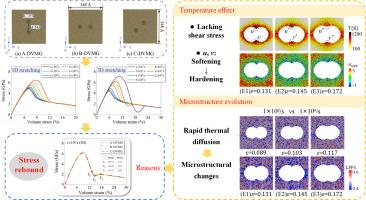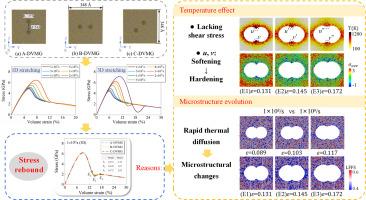金属玻璃动态空洞合并后的异常应力回弹
IF 12.8
1区 材料科学
Q1 ENGINEERING, MECHANICAL
引用次数: 0
摘要
了解孔隙聚并的微观机制是评价结构材料动态损伤积累的必要条件。然而,这种瞬态过程的实验表征仍然极具挑战性。本文采用分子动力学方法,系统研究了单轴(1D)和三轴(3D)拉伸加载条件下,金属玻璃(MG)原型中预先存在的空洞的空间排列以及应变速率对动态空洞聚并的影响。研究发现,在一维加载下,孔洞的排列只影响应力-应变响应,而不影响孔洞的生长和聚并速度。而在三维动载荷作用下,孔洞闭合后,孔洞周围温度明显降低。从原子堆积的角度来看,随着应变速率的增加,机械稳定的<;0、0、12、0>;原子Voronoi多面体的数量恢复。因此,由于意想不到的微观组织硬化效应,材料在空洞聚结后会出现异常的应力反弹,而这在结晶金属中是不存在的。同时,可以通过调整孔隙特性或材料参数来控制应力回弹强度。这种不寻常的应力反弹可能会在极端条件下应用于金属材料。本文章由计算机程序翻译,如有差异,请以英文原文为准。


Abnormal stress rebound after dynamic void coalescence in metallic glasses
Understanding the microscopic mechanism of void coalescence is essential for evaluating the accumulation of dynamic damage in structural materials. However, experimental characterization of such a transient process remains extremely challenging. Here, the spatial arrangement of pre-existing voids and the influence of strain rate on dynamic void coalescence in a prototypical metallic glass (MG) are systematically investigated by molecular dynamics under conditions of uniaxial (1D) and triaxial (3D) tensile loading. It is found that, under 1D loading, the void arrangement affects only the stress-strain response, without impacting the growth and coalescence rate of the voids. However, under 3D dynamic loading, temperature around the voids undergoes a significant decrease after void coalescence. From the perspective of atomic packing, the number of mechanically stable <0,0,12,0> atomic Voronoi polyhedra recovers as strain rate goes up. As a result, material experiences abnormal stress rebound after void coalescence due to the unexpected microstructural hardening effect, which is absent in crystalline metals. Meanwhile, the stress rebound strength can be controlled by adjusting void characteristics or material parameters. This unusual stress rebound might find applications for metallic materials under extreme conditions.
求助全文
通过发布文献求助,成功后即可免费获取论文全文。
去求助
来源期刊

International Journal of Plasticity
工程技术-材料科学:综合
CiteScore
15.30
自引率
26.50%
发文量
256
审稿时长
46 days
期刊介绍:
International Journal of Plasticity aims to present original research encompassing all facets of plastic deformation, damage, and fracture behavior in both isotropic and anisotropic solids. This includes exploring the thermodynamics of plasticity and fracture, continuum theory, and macroscopic as well as microscopic phenomena.
Topics of interest span the plastic behavior of single crystals and polycrystalline metals, ceramics, rocks, soils, composites, nanocrystalline and microelectronics materials, shape memory alloys, ferroelectric ceramics, thin films, and polymers. Additionally, the journal covers plasticity aspects of failure and fracture mechanics. Contributions involving significant experimental, numerical, or theoretical advancements that enhance the understanding of the plastic behavior of solids are particularly valued. Papers addressing the modeling of finite nonlinear elastic deformation, bearing similarities to the modeling of plastic deformation, are also welcomed.
 求助内容:
求助内容: 应助结果提醒方式:
应助结果提醒方式:


